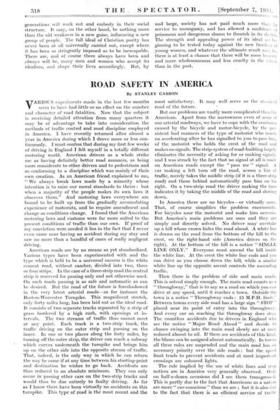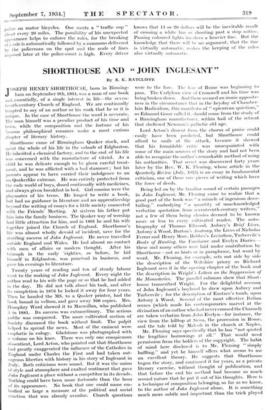ROAD SAFETY IN AMERICA
By STANLEY CASSON
VARIOUS experiments made in the last few months seem to have had little or no effect on the number and character of road fatalities. Now that the subject is receiving detailed attention from many quarters it may be of advantage to take into consideration the methods of traffic control and road discipline employed in America. I have recently returned after almost a year in America during which I drove more or less con- tinuously. I must confess that during my first few weeks ,a driving in England I felt myself in a totallY different motoring world. American drivers as a whole strike me as having definitely better road manners, as being more considerate to other drivers and to pedestrians and as conforming to a discipline which was mainly of their own creation. As an American friend explained to me, "We always break laws made by a minority whose intention is to raise our moral standards to theirs : but when a majority of the people makes its own laws it observes them." And motoring laws everywhere are bound to be built up from the gradually accumulating experience of motorists, and to require amendment and change as conditions change. I found that the American motoring laws and customs were far more suited to the present conditions of traffic than our own. If proof of my conviction were needed it lies in the fact that I never even came near having an accident during my stay and saw no more than a handful of cases of really negligent driving.
American roads are by no means as yet standardized. Various types have been experimented with and the type which is held to be a universal success is the white cement road, without camber, divided into two, three or four strips. In the case of a three-strip road the central strip is reserved for passing only and not otherwise used. On such roads passing is as safe and automatic as can be desired. But the road of the future is foreshadowed in the very latest arterial roads—as for instance the Boston-Worcester Turnpike. This magnificent stretch, only forty miles long, has been laid out as the ideal road. It consists of two separate tracks separated by a strip of grass bordered by a high curb, with openings at in- tervals. The two streams of traffic thus cannot meet at any point. Each track is a two-strip track, the traffic driving on the outer strip and passing on the inner. In one or two places along the forty miles, by turning off the outer strip, the driver can reach a subway which curves underneath the turnpike and brings him up on the other side into the opposite stream of traffic. That, indeed, is the only way in which he can return the way he came if at any time between his starting-point and destination he wishes to go back. Accidents are thus reduced to an absolute minimum. They can only occur in passing other cars on the two-strip tracks and would thus be due entirely to faulty driving. As far as I know there have been virtually no accidents on this turnpike. This type of road is the most recent and the most satisfactory. It may well serve as the stainkal road of the future. • But our problems are vastly more complicated than the American. Apart from the narrowness even of sonic, of our arterial roadways, we have to cope with the confusion caused by the bicycle and motor-bicycle, by the per- sistent bad manners of the type of motorist who insists on accelerating after he has signalled to you to pass him, of the motorist who holds the crest of the road and makes no signals. The strip-system of road-building largely eliminates the necessity of asking for or making signals, and I was struck by the fact that no signal at all is made on American roads except the "pass me" signal. A car making a left turn off the road, across a line of traffic, merely takes the middle strip (if it is a three-strip road) and those behind automatically pass him on his right. On a two-strip road the driver making the turn indicates it by taking the middle of the road and slowing down.
In America there are no bicycles—or virtually none. That, of course simplifies the problem enormously. For bicycles sour the motorist and make him nervous. But America's main problems are ours and . they are simply and directly solved. No driver may overtake up a hill whose crown hides the road ahead. A white line is drawn on the road from the bottom of the hill to the crest, on the right-hand side (America drives on the right). At the bottom of the hill is a notice "SINGLE LINE ONLY." Everyone must ascend the hill_ inside the white line. At the crest the white line ends and you can drive as you choose down the hill, while a similar white line up the opposite ascent controls the ascending traffic.
Then there is the problem of side and main roads. This is solved simply enough. The main road counts as a "throughway," that is to say as a road on which you can drive at any speed, until it reaches a town. Outside the town is a notice "Throughway ends : 25 M.P.H. limit." Between towns every side road has a large sign "STOP" placed near its point of entry into the throughway. And every car on reaching the throughway does stop. The countless accidents due to drivers in England who see the notice "Major Road Ahead" and decide to chance swinging into the main road slowly are at once reduced almost to nil. If there are accidents of this kind, the blame can be assigned almost automatically. In towns all these rules are suspended and the Main road has no necessary priority over the side roads : but the speed limit tends to prevent accidents and at most important crossings are coloured lights.
The rule implied by the use of white lines and stop notices are in America very generally observed. Oily on half-a-dozen occasions did I see them transgressed. This is partly due to the fact that Americans as a nation are more " car-conscious " than we are ; but it is also due to the fact that there is an efficient service of traffic police on motor bicycles. One meets a "traffic cop" about every 20 miles. The possibility of his unexpected appearance helps to enforce the rules, for the breaking of a rule is automatically followed by a summons delivered by the policeman on the spot and the scale of fines imposed later at the police-court is high. Every driver knows that 15 or 20 dollars will be the inevitable result of crossing a white line or shooting past a stop notice. Passing coloured lights involves a heavier fine. But the knowledge that there will be no argument, that the line is virtually automatic. makes the keeping of the rules also virtually automatic.







































 Previous page
Previous page